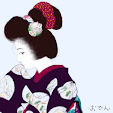
At new year, Japanese lion dance called "Shishi-mai" is held in many places.
There is a tradition that children who have their head bitten by Shishi will be happy.
(Photo : "Shishi-gashira (lion's head)" that is a mask for "Shishi-mai". by (c)Tomo.Yun)
(Video : "Shishi-mai".)
● Shogatsu / Oshogatsu (the New Year)
Originally, it's an another name of January.
But recently, it means "Sanganichi" (days from 1st to 3rd Jan.) or "Matsuno-uchi" (days from 1st to 7th Jan.).
New Year's Day is called "Ganjitsu", and morning of New Year's Day is called "Gantan".
Eating Osechi, reading Nengajo, visiting shrine as Hatsumode, meeting to relatives and playing with traditional toys.
Famous toys are "Hanetsuki (battledore and shuttlecock)", "Tako (kite)", "Koma (spinning a top)", "Sugoroku (backgammon)", "Fuku-warai (making funny face, like "pin the tail on the donkey"), "Karuta (card game)" and so on.
And a lot of people surge to department stores for New Year's sales that are called "Hatsu-uri".
● Hatsu-hinode (the first sunrise)
Watching the first rising sun with reverence.
To watch beautiful and holy sunrise from top of a mountain, a lot of people climb a mountain, especially Mt. Fuji.
The sunrise that is watched from mountain is called "Go-raiko".
(Photo : Hatsu-hinode.)

● Osechi Ryori / Osechi (special dishes for New Year)
During New Year, there is a "Toshigami" inside our house and we have to be quiet at kitchen.
To keep kitchen quiet, and to give homemakers the day off, a lot of auspicious dishes are cooked before New Year's Day.
Making Osechi is very tough work and chance to show her stuff for homemaker.

● Otoso / Toso (special sake for New Year)
A kind of Osechi, and a kind of drug.
It's made from spices called "Tososan", Sake, Mirin (sweet sake for seasoning) and sugar.
Wishing to keep health and drinking it.
(Photo : Tablewares for Toso called "Tosoki".)

● Ozoni / Zoni (Mochi soup eaten on New Year)
A kind of Osechi.
There are various kind of Zoni according to locality.
(Photo : Edo (Tokyo) style Zoni.)

● Hatsu-mode / Hatsu-mairi
The first shrine visiting of the year.
Each shrine is crowded with people praying.
Originally, it's visiting "Ujigami" (guardian deity) or visiting some shrine or temple standing on a good-luck-azimuth of the year.
But recently, visiting famous great shrine or temple is popular.
At first, praying for thanks of last year and wish of this year.
And, buying lucky charm and "Hamaya (arrow used in exorcising ceremony)" etc..
Writing wish at an "Ema (small board of wood)", and drawing out "Omikuji (sacred lot)" as fortune-telling.
(Photo : Hatsu-mode. by (c)Tomo.Yun)

● Nengajo / Nenshijo (New Year's card)
Maybe it's same as Christmas card.
Though young people are shifting to using e-mail, a lot of people are still writing or printing hundreds of postcards.
Usual design is the symbolic animal of the year that is based on "Eto / Junishi (twelve signs of the zodiac)". (2010 is the tiger.)
Another popular designs are "Takara-bune (treasure ship)", "Shichi-fuku-jin (seven gods of good fortune)" or something symbolizing early spring.
● Otoshidama / Toshidama (New Year's gift)
Superiors or senior people give money, sweets or goods to inferiors or junior people.
Generally, children are given some money by parents and adult relatives.
It's a big income for children.
● Hatsu-yume (the first dream)
A dream of the second night of the New Year.
If there are Mt. Fuji, hawk or eggplant in your dream, you are lucky for this year.
● Nanakusa-gayu
Rice gruel containing Nanakusa (seven spring herbs) eaten at 7th Jan..
Wishing to keep health and giving stomach a rest.

● Kagami-biraki
Breaking and eating Kagamimochi at 11th Jan.
Cutting Kagamimochi by knife is inauspicious, and it is broken by hummer.
It's usually cooked sweet red-bean soup called "Oshiruko / Shiruko".
(Photo : Oshiruko.)

Yes, year end and new year is the biggest event in Japan.
People enjoy these things with family, friends or lover.
And at the New Year's Day, a lot of people wear kimono.
It's a very formal and traditional day for us.
Though most of Japanese are living in Western style, we spend New Year's Day traditionally.
I'll visit Kasuga Taisha Shrine in kimono for Hatsu-mode.
I wish your Happy New Year!


So many New Year traditions! It is so exciting :) :) :) I wish to visit Japan during Christmas and New Year one day :)
ReplyDeleteLyuba-chan,
ReplyDeleteYou can see Japan just like Japan during year end and new year!
But most of these customs are seen at each home.
I'll search for places where you can experience these customs, maybe in next Nov.. :)